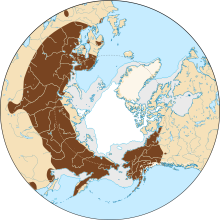Tundra vole
| Tundra vole | |
|---|---|

| |
| Tundra vole in Alaska | |
| Scientific classification | |
| Domain: | Eukaryota |
| Kingdom: | Animalia |
| Phylum: | Chordata |
| Class: | Mammalia |
| Order: | Rodentia |
| Family: | Cricetidae |
| Subfamily: | Arvicolinae |
| Genus: | Alexandromys |
| Species: | A. oeconomus
|
| Binomial name | |
| Alexandromys oeconomus (Pallas, 1776)
| |

| |
| Synonyms[1] | |
| |
The tundra vole (Alexandromys oeconomus) or root vole is a medium-sized vole found in Northern and Central Europe, Asia, and northwestern North America, including Alaska and northwestern Canada.[2] In the western part of the Netherlands, the tundra vole is a relict from the ice age and has developed into the subspecies Alexandromys oeconomus arenicola.
Description
[edit]The tundra vole has short ears and a short tail. Its fur is yellowish brown with paler sides and white underparts. It is typically about 18 cm (7.1 in) long with a 4 cm (1.6 in) tail and a weight of about 50 grams (1.8 oz).
Habitat
[edit]The tundra vole is found in damp tundra or moist meadows, usually near water.
Behaviour and diet
[edit]This species makes runways through the surface growth in warm weather and tunnels through the snow in winter. It feeds on grasses, sedges and seeds. It is active year-round. It also digs burrows where it stores seeds and roots, especially licorice root, for the winter.
Breeding
[edit]Female voles have three to six litters of three to nine young in a shallow burrow. The vole population in a given area can vary greatly from year to year.
Subspecies
[edit]Subspecies are as follows:[3]
- A. o. amakensis - Amak Island tundra vole - Alaska, United States
- A. o. arenicola - Dutch tundra vole - Netherlands
- A. o. elymocetes - Montague Island tundra vole - Alaska, United States
- A. o. finmarchicus - Norwegian tundra vole - Norway
- A. o. innuitus - St. Lawrence Island tundra vole - Alaska, United States
- A. o. medius - Norwegian tundra vole - Norway
- A. o. mehelyi - Central European tundra vole - Austria, Hungary and Slovakia
- A. o. oeconomus - nominate subspecies - widespread
- A. o. popofensis - Shumagin Islands tundra vole - Alaska, United States
- A. o. punakensis - Punuk Islands tundra vole - Alaska, United States
- A. o. sitkensis - Alexander Archipelago tundra vole - Alaska, United States
- A. o. unalascensis - Unalaska Island tundra vole - Alaska, United States
References
[edit]- ^ a b Linzey, A.V.; Shar, S.; Lkhagvasuren, D.; Juškaitis, R.; Sheftel, B.; Meinig, H.; Amori, G. & Henttonen, H. (2017) [errata version of 2016 assessment]. "Microtus oeconomus". IUCN Red List of Threatened Species. 2016: e.T13451A115113894. doi:10.2305/IUCN.UK.2016-3.RLTS.T13451A22347188.en. Retrieved 19 February 2022.
- ^ "Alexandromys oeconomus". ASM Mammal Diversity Database. American Society of Mammalogists.
- ^ Witte van den Bosch, R. and Bekker, D. (2009). Verdwijnt de oer-Hollandse lemming? Geschiedenis en toekomst van de noordse woelmuis. Zoogdier 20-4: p.p 3-7. (in Dutch)
Text is available under the CC BY-SA 4.0 license; additional terms may apply.
Images, videos and audio are available under their respective licenses.

